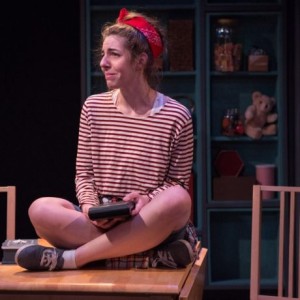 “Static” is just the kind of play you might expect from a former longtime sound theatrical sound designer. But author Tom Horan is also an accomplished playwright, which sort of makes him a ringer in the ninth Source Festival organized by CulturalDC as a way to bring the spotlight to new and emerging writers.
“Static” is just the kind of play you might expect from a former longtime sound theatrical sound designer. But author Tom Horan is also an accomplished playwright, which sort of makes him a ringer in the ninth Source Festival organized by CulturalDC as a way to bring the spotlight to new and emerging writers.
Many of those appear in the 18 10-minute plays that are organized around the themes of the three full-length works, one of which is “Static.”
In it, a young woman dealing with her father’s death learns he also owned the house next door owned by a strange couple who hoarded a lot of things. Going through the things in that house to prepare it for sale, she finds that one of those things is a tape recorder onto which the former resident, Walter Burke (played by Keith Richards, and not the one you’re thinking of) also collected various sounds: birds, drips, wind — each categorized by date and his name, oddly.
The young woman, Emma (Amy Horan), becomes intrigued by the tapes, their strange one-sided conversations and his declaration at one point that he has recorded the voice of ghosts.
Anybody who watches “Ghost Hunters” knows that one way to capture the voice of spirits is to leave a recorder on and turn up the playback really loud. That’s not the method here. Instead, it’s a much more clear voice of someone unknown to Walter.
Walter’s wife Millie (Megan Reicheit) has a haunting presence. She walks around the house silently, looks out the window, and communicates by writing notes.
Emma’s finance (Dylan Jackson) is trying to be patient with her obsession with the house and its secrets, but there is indeed a resolution of what’s going on that comes together all very quickly considering it took an hour to get there (and the audience might be a bit ahead in detecting what’s next).
Perhaps the mentoring of playwrights in Source Festival should be moved as well to directors, as Bridget Grace Sheaff moves things very slowly, suggesting “Static” might be a better length somewhere between the 10-minute plays and a full length one.
More surprising, perhaps, many be the sonics (Gordon Nimmo-Smith was sound designer). The Source space is small enough that the sound of the critical tape recorder would have carried throughout the room; instead, all of the various sounds of the various tapes come through the overhead sound system, where they can be confused with occasional bumps in the room, which sound as if they’re from the same source.
It would have been a delicate choreography to keep all the various cassette tapes straight, but I think it would have added more immediacy and realism to the thing.
The set by Glyph Stanford consists of a wall of shelves and cubbies that suggests less hoarding than artful design. The fact it has one drawer because the script calls for a drawer takes from the realism as well.
Sometimes these sets are designed to work for the accompanying plays as well, though.
As lead, Amy Horan brings a lot of energy to the show; she and Jackson make a convincing urban couple on the rise. The bearded Keith Richards, for his part, may not be as old and creepy as Walter ought to be (or old and creepy as the guitarist of the same name). But Reichelt does a lot to bring the eeriness, single handedly.
As one of three full-length plays in the Source Festival, “Static” provides the theme for an additional set of 10-minute plays, and an “Artistic Blind Date” performance titled “Lost & Sound.”
The other full length plays are “Buried Cities” by Jennifer Fawcett, heading up a “Heroes & Home” set of plays; and “Ballast” by Georgette Kelly, accompanied by plays on the theme of “Dreams & Discord.”
“Static” will be repeated June 17, 25, 29 and July 3. The Source Festival continues through July 3.